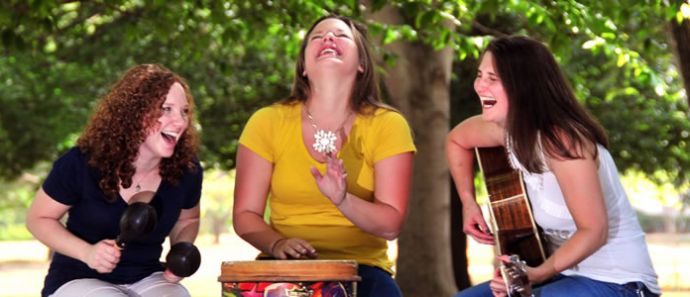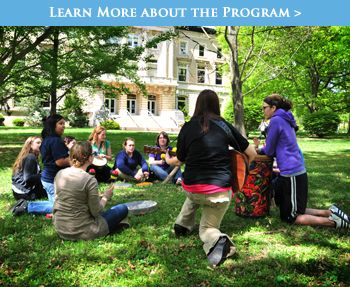Music Therapy Professors Keep Students In Tune and Inspired
By: Katie Shane

For Briana Priester, a small “Hello” can be huge.
The board certified music therapist experienced a true breakthrough with one of her clients during a traditional weekly session. Asking her client, a young boy with autism, questions about time, colors and his family, Priester began to sing as she continued her questions.
“We are sitting and having this musical conversation and I sing ‘If you meet someone new what do you say…’ he looks right up at me and looked me in the eye and said ‘Hello.’ Normally his mind thinks it, but his mouth can’t say it,” she explains. “Without prompting he then said ‘How are you?’ (The boy’s mother) looked at me and was shocked.”
Personal breakthroughs and triumphs don’t happen during every music therapy session, but every therapist can recall at least one, if not many, amazing patient moments within their career.
“I just feel lucky to have these people in my life every day. It’s less about emotion seeking but the chance to provide that for the family and allow them to have positive experiences with their children,” Priester says.
Not only does Priester have the privilege of sharing these moments with her patients, but often times she shares those moments with her former professors at Saint Mary-of-the-Woods College.
Tracy Richardson, director of the Master’s of Art in music therapy program, and Sharon Boyle, associate professor of music therapy, say they love to hear that the College’s music therapy program is helping students help others.
“That is the best part,” Boyle says with a smile.
Adds Richardson with a laugh, “That is the middle of the Oreo.”
Described as a healthcare profession, music therapy is used to make changes and reach goals in patients with conditions such as Autism or Alzheimer’s or patients who have suffered a stroke.
“Music therapy is a challenge to explain and define because it draws from so many other disciplines,” Boyle explains. “Psychology, anthropology, sociology, neuroscience, music, counseling… it is at once an art and a science, and contains an interpersonal process.”
There are only a small number of higher education institutions in the country that offer a music therapy degree and SMWC is at the top of the list for many students, especially considering the versatility of program offerings.
The undergrad degree program began in 1983 and the master’s degree was added in 2000.
As the field of music therapy began to grow, so did the need for additional opportunities of study.
Richardson says for years she received calls from prospective students asking about the degree. Many of those students already had a music degree, but wanted to pursue a career in music therapy.
“I got called for ten years,” Richardson says. “I would listen to (prospective students) on the phone, ’I live in Nebraska, and I have a music degree. I need to do something else and this is it.’ You can only listen to that for so many years before you have to do something.”
That’s when the Music Therapy Equivalency – Campus Program was born.
The non-degree program, approved by the American Music Therapy Association, gives students the opportunity to study in the field of music therapy on the SMWC campus. The program is open to men and women who already have a bachelor’s degree in music.
But Richardson and her colleagues didn’t stop at just an on-campus equivalency program. In 2012 the college began another branch of the program: the Music Therapy Equivalency Distance Program (MTED).
“For ten years we worked on (the program) to get it in shape,” Richardson explains. “People were very skeptical.”
It’s understandable people may have questions about the program, as music therapy is not a typical career that can be taught online. But SMWC had the answer. Students in the MTED program visit campus for a three-day residency during the fall and winter and a five-day residency in May. In addition students complete coursework online and clinical training during practicums in their own local area in which they live.
For students like Bethany Rice, the MTED program was exactly what she was looking for.
“I started looking around at schools that offered the program,” she explains. “There aren’t a lot of them and I was going to have to move or find an online program but it turned out the SMWC was the only program out there at the time.”
And is still the only program; SMWC offers the only online equivalency program in the nation.
For Rice, who lives in Lawrenceburg, Ind., with her husband, the online aspect of the course isn’t seen as challenging; it’s enjoyable as she connects with her classmates online.
“It gives you a good network that you are working with and that actually is wonderful because in the future you will be able to draw from those connections,” Rice says. “We have become a community online. I feel very connected with them, and it’s set me up for success in a lot of ways.”
Students enrolled in both the campus and distance programs come from all over. Boyle says the diversity of students is just one of the many unique aspects of the program and career.
Boyle says one of the program’s most diverse students, and maybe one of the hardest working students, is Nathan Mensah. Being a male in an exclusively female college no doubt makes Mensah truly unique.
“Nate and I wrote back and forth through email for weeks, he kept on me so I met with him,” Boyle explains of Mensah’s desire to enter the program. “I told him the only way this could work is if he started the equivalency program.”
Mensah, who has played music since childhood, is not only working and taking classes at SMWC, but is concurrently completing a music degree at Indiana State University, only miles away from The Woods campus.
“When I was looking for a school to go to for music therapy, for me in my mind it was a landslide because I felt really reeled in by the staff,” Mensah, a Fort Wayne, Ind., native says. “SMWC was very willing to work with me even though I was a male and had a music background. We are very, very lucky to have (Richardson and Boyle) and the rest of the professors who are strong at their craft. They want us to be the strongest we can be.”
That feeling of admiration for the music therapy professors is shared by another SMWC equivalency student, Bethann Smith.
Smith completed the program five years ago and is now working as a music therapist in Terre Haute, Ind.
An educator specializing in music for years, Smith says she didn’t know her career potential until enrolling at SMWC.
“The Woods gave me wings to a vision to something I didn’t know I had,” Smith explains. “I had a lot of the tools under my belt but I never put wings to the tools.”
Like Mensah, Smith is an example of a student juggling a current career and future aspirations. While enrolled in the Equivalency program Smith worked and studied, sometimes at the same time.
“I was able to (enroll) and keep a full-time job. I could do the full-time job and the classes during my lunch hour,” she says. “It was like they said, ‘We are here if you want it, it’s here, the only reason you can’t is if you aren’t trying’.”
Richardson admits the coursework is challenging, but the payoff is worth the hard work.
“I think that comes from the philosophy of the nuns (that founded the college), they had a mission to change things and I think that the equivalency program continues that,” she says. “It’s not just teaching a class and giving a grade, music therapy is rare that you can come out of a program and you are a therapist. It’s a lot to cram into that time. “
For former students like Priester, it’s difficult not to aspire for the best when working with professors like Boyle and Richardson, especially on the SMWC campus.
“It’s kind of a magical place; once you go to The Woods you never really leave,” she says from her home in rural Virginia. “I knew my five-year plan, and they were really good at supporting that but reminded me that becoming a music therapist is a journey… they don’t just teach… that is really what makes this program sparkle. It’s really incredible.”
